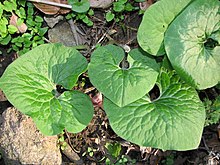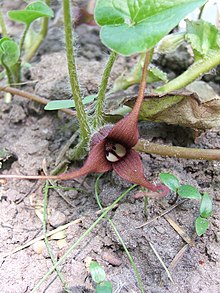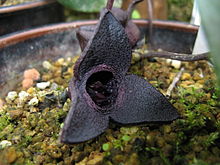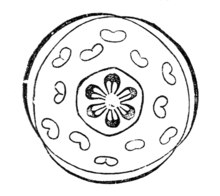Hazel root
| Hazel root | ||||||||||||
|---|---|---|---|---|---|---|---|---|---|---|---|---|

Common hazel root ( Asarum europaeum ), illustration |
||||||||||||
| Systematics | ||||||||||||
|
||||||||||||
| Scientific name | ||||||||||||
| Asarum | ||||||||||||
| L. |
The plant genus of subungulates ( Asarum ) belongs to the subfamily of Asaroideae within the family of aristolochiaceae (Aristolochiaceae). The 90 to 100 species are common in the northern hemisphere .
Description and ecology
In Asarum TYPES is perennial herbaceous plants . They form rhizomes . The aboveground plant parts are mostly hairy. There are triangular lower leaves on the stem axis . The alternate and two-line, long-stalked leaves are simple, rounded to kidney-shaped or heart-shaped. The leaf margin is smooth.
The flowers are usually solitary near the ground; There are no bracts. The hermaphrodite flowers are usually radial symmetry , rarely weakly zygomorphic . There are only three more or less strongly overgrown bracts . They have twelve stamens divided into two circles . The ovaries are subordinate or semi-subordinate.
Six-lobed capsule fruits are formed. The seeds carry elaiosomes and are spread by ants ( myrmecochory ).
Ingredients and toxicity
The rhizome contains camphor-like, essential substances that irritate the mucous membranes, stimulate vomiting and sneezing and can trigger internal bleeding (gastroenteritis).
All parts of the plant contain essential oils , the component of which asarone is poisonous ; the whole plant is classified as slightly poisonous.
Systematics and distribution
The Euro-Asian-North American common genus includes around 90 to 100 species worldwide. The focus of biodiversity is Southeast Asia . 39 species are found in China alone, 34 of which are native to China. In Central Europe only the species common hazel root ( Asarum europaeum ) occurs.
The genus Asarum was established in 1753 with the type species Asarum europaeum by Carl von Linné in Species Plantarum , 1, p. 442. An interpretation of the generic name Asarum is derived from the Greek word asaron = branchless, i.e. unbranched. The other interpretation is that Asarum was used in the Greek language for a type of plant, but it is not known which type it is. Synonyms for Asarum L. are: Asiasarum F.Maek. , Geotaenium F. Maek. , Heterotropa C. Morren & Decne. , Japonasarum Nakai .
Some authors have included around ten North American species ( Asarum arifolium , Asarum contractum , Asarum lewisii , Asarum minus , Asarum naniflorum , Asarum rhombiforme , Asarum shuttleworthii , Asarum speciosum , Asarum virginicum ) in their own genus Hexastylis Raf. outsourced.
Types (selection)




There are around 90 to 100 species of Asarum :
- Asarum asaroides (C. Morren & Decne.) Makino : It occurs in Japan in western Honshu and northern Kyushu .
- Asarum bashanense Z.L.Yang : It occurs only in the Chinese province of Sichuan at altitudes between 700 and 900 meters.
- Asarum campaniflorum Wang Yong & QFWang : It occurs only in the Chinese province of Hubei at altitudes between 350 and 450 meters.
- Canadian Hazel Root ( Asarum canadense L. ): It thrives in deciduous forests at altitudes between 0 and 1,300 meters in Canada and in the northern and southeastern United States.
- Asarum cardiophyllum Franchet : It occurs only in the Chinese provinces of Sichuan and Yunnan at altitudes of around 1100 meters.
- Tailed hazel root ( Asarum caudatum Lindl. ): It thrives in coniferous forests at altitudes of mostly 0 to 1200 (rarely up to 2200) meters in North America, namely in British Columbia, Oregon, Washington, in northern Idaho, in western Montana and in northern and western California.
- Asarum caudigerellum C.Y.Cheng & CSYang : It thrives at altitudes between 1,600 and 2,100 meters in the Chinese provinces of Guizhou , Hubei, Sichuan and northeastern Yunnan.
- Asarum caudigerum Hance : It thrives at altitudes between 300 and 1700 meters in the Chinese provinces of Fujian , Guangdong , Guangxi , Guizhou , Hubei, Hunan , Sichuan, Yunnan; also in Taiwan , Vietnam and the Ryūkyū Islands .
- Asarum caulescens Maxim. : It thrives at altitudes between 700 and 1700 meters in the Chinese provinces of Gansu, Guizhou, Hubei, Shaanxi , Sichuan and is also found in Japan.
- Asarum chengkouense Z.L.Yang : It occurs only in the Chinese city of Chongqing at altitudes between 1000 and 1200 meters.
- Asarum chinense Franchet : It thrives at altitudes between 1,300 and 1,500 meters in the Chinese provinces of western Hubei and northeastern Sichuan.
- Asarum crassisepalum S.F. Huang et al. : It occurs only in Taiwan at altitudes between 1600 and 1700 meters.
- Asarum crispulatum C.Y.Cheng & CSYang : It occurs only in the Chinese province of Sichuan .
- Asarum debile Franchet : It thrives at altitudes between 1,300 and 2,300 meters in the Chinese provinces of Anhui , Hubei, Shaanxi and Sichuan.
- Asarum delavayi Franchet : It thrives at altitudes between 800 and 1,600 meters in the Chinese provinces of southwestern Sichuan and northeastern Yunnan.
- Asarum epigynum Hayata : It occurs only in the Chinese province of Hainan and in Taiwan.
- Common hazel root ( Asarum europaeum L. ): It is widespread in Eurasia from southwest and south via central to north and east to south- east Europe and from Turkey via Georgia, Ukraine and Crimea to southern western Siberia .
- Asarum forbesii Maxim. : It thrives at altitudes below 800 meters in the Chinese provinces of Anhui, Henan, Hubei, Jiangsu, Jiangxi, Sichuan and Zhejiang .
- Asarum fukienense C.Y.Cheng & CSYang : It thrives at altitudes between 300 and 1000 meters in the Chinese provinces of Anhui, Fujian , Jiangxi and Zhejiang.
- Asarum geophilum Hemsley : It thrives at altitudes between 200 and 700 meters in the Chinese provinces of Guangdong, Guangxi and southern Guizhou.
- Hartweg's hazel root ( Asarum hartwegii S. Watson ): It only thrives in California at altitudes between 150 and 2200 meters .
- Asarum heterotropoides F.Schmidt : It occurs only in the southern Chinese provinces of Heilongjiang , Jilin , Liaoning and Japan .
- Asarum himalaicum Hook. f. & Thomson ex Klotzsch : It thrives at altitudes between 1,300 and 3,100 meters in India , Bhutan , Nepal and Sikkim and in the Chinese provinces of Gansu, Guizhou, western Hubei, Shaanxi, Sichuan and Tibet .
- Asarum hongkongense S.M. Hwang & TPWong Siu : It occurs only in Hong Kong at altitudes between 500 and 700 meters.
- Asarum hypogynum Hayata (Syn .: Asarum hayatanum (F.Maek.) F.Maek. Ex Masam. ): It occurs only in Taiwan at altitudes between 1000 and 2000 meters.
- Asarum ichangense C.Y.Cheng & CSYang : It thrives at altitudes between 300 and 1400 meters in the Chinese provinces of Anhui, Fujian, Guangdong, Guangxi, Hubei, Hunan, Jiangxi and Zhejiang.
- Asarum inflatum C.Y.Cheng & CSYang : It occurs in the Chinese provinces of Anhui and northeast Sichuan.
- Asarum insigne Diels : It thrives at altitudes of around 500 meters in the Chinese provinces of Guangdong, Guangxi and Jiangxi.
- Asarum lemmonii S. Watson : It is only found in California at altitudes between 1100 and 1900 meters.
- Asarum longerhizomatosum C.F. Liang & CSYang : It occurs only in the Chinese autonomous region of Guangxi at altitudes of about 200 meters.
- Asarum macranthum J.D. Hooker : It occurs only in Taiwan at altitudes between 500 and 1000 meters.
- Asarum magnificum Tsiang ex CYCheng & CSYang : It thrives at altitudes between 300 and 700 meters in the Chinese provinces of Guangdong and Hunan.
- Asarum majale T.Sugaw. : This endemic was first described in 2007 and thrives in the Suzuka mountain range in the Japanese district of Kinki .
- Asarum marmoratum Piper : This species is only found in the Cascades and Siskiyou Mountains of southern Oregon and the extreme northwestern part of California .
- Asarum maximum Hemsley : It thrives at altitudes between 600 and 800 meters in the Chinese provinces of Hubei and Sichuan.
- Asarum megacalyx (F.Maek.) T.Sugaw. : It thrives near the coast of the Japan Sea at Tohoku on Honshu Island.
- Asarum nanchuanense C.S.Yang & JLWu : It occurs only in the Chinese city of Chongqing .
- Asarum nipponicum F. Maek. : It occurs on the Japanese islands of Honshu and Shikoku .
- Asarum nobilissimum Z.L.Yang : It occurs only in the Chinese province of Sichuan at altitudes between 800 and 1100 meters.
- Asarum petelotii OCSchmidt : It occurs only in the southern part of the Chinese province of Yunnan and in Vietnam at altitudes between 1100 and 1700 meters.
- Asarum porphyronotum C.Y.Cheng & CSYang : It occurs only in the Chinese province of Sichuan.
- Asarum pulchellum Hemsley : It thrives at altitudes between 700 and 1700 meters in the Chinese provinces of Anhui, Guizhou, Hubei, Jiangxi, Sichuan and northeastern Yunnan.
- Asarum renicordatum C.Y.Cheng & CSYang : It occurs only in the Chinese province of Anhui at altitudes of about 700 meters.
- Asarum sagittarioides C.F. Liang : It occurs only in the Chinese Autonomous Region of Guangxi at altitudes between 900 and 1200 meters.
- Asarum Sieboldii Miquel : It occurs in the Chinese provinces of Anhui, Henan, Hubei, Liaoning, Shaanxi, Shandong, Shanxi, Sichuan and Zhejiang, also in Japan and in northern and southern Korea.
- Asarum splendens (F.Maekawa) CYCheng & CSYang : It thrives at altitudes between 800 and 1,300 meters in the Chinese provinces of Guizhou, Hubei, Sichuan and northeastern Yunnan.
- Asarum taipingshanianum S.F. Huang, CXXie & TCHuang : It occurs only in Taiwan at altitudes of around 1900 meters.
- Asarum tongjiangense Z.L.Yang : It occurs only in the northeastern part of the Chinese province of Sichuan at altitudes between 800 and 1400 meters.
- Asarum wagneri K.L.Lu & Mesler : It is endemic to the Cascade Range of southern Oregon .
- Asarum wulingense C.F.Liang : It thrives at altitudes of around 1100 meters in the Chinese provinces of Guangdong, Guangxi, Guizhou, Hunan and Jiangxi.
- Asarum yoshikawae T. Sugawara : It was first described in 1998 and occurs in Japan.
- Asarum yunnanense T.Sugawara, Ogisu & CYChen : It occurs only in the southern part of the Chinese province of Yunnan.

Cultural meaning
The Tokugawa family, who ruled Japan for over 250 years in the Edo period, had three hazel root leaves in a circle ( Japanese: Maru-ni-mitsuba-aoi ) in their family crest .
swell
- Alan T. Whittemore, Michael R. Mesler & Karen L. Lu: Asarum - the same text online as the printed work , In: Flora of North America Editorial Committee (ed.): Flora of North America North of Mexico , Volume 3 - Magnoliidae and Hamamelidae , Oxford University Press, New York a. a. 1997, ISBN 0-19-511246-6 . (Section description, systematics and dissemination)
- Shumei Huang, Lawrence M. Kelly, Michael G. Gilbert: Aristolochiaceae. : Asarum , p. 246 - the same text online as the printed work , In: Wu Zhengyi, Peter H. Raven & Deyuan Hong (eds.): Flora of China , Volume 5 - Ulmaceae through Basellaceae , Science Press and Missouri Botanical Garden Press, Beijing and Saint Louis, 2003, ISBN 1-930723-27-X . (Section description, systematics and dissemination)
Individual evidence
- ^ Asarum at Tropicos.org. Missouri Botanical Garden, St. Louis, accessed August 10, 2014.
- ↑ a b Alan T. Whittemore, Michael R. Mesler, Karen L. Lu: Asarum - online with the same text as the printed work , In: Flora of North America Editorial Committee (Ed.): Flora of North America North of Mexico , Volume 3 - Magnoliidae and Hamamelidae , Oxford University Press, New York and Oxford, 1997. ISBN 0-19-511246-6
- ↑ a b c d e f g h i Asarum in the Germplasm Resources Information Network (GRIN), USDA , ARS , National Genetic Resources Program. National Germplasm Resources Laboratory, Beltsville, Maryland.
- ↑ a b c d e f g h i j k l m n o p q r s t u v w x y z aa ab ac ad ae af ag ah ai aj ak al am an ao Shumei Huang, Lawrence M. Kelly, Michael G. Gilbert: Aristolochiaceae. : Asarum , p. 246 - the same text online as the printed work , In: Wu Zhengyi, Peter H. Raven & Deyuan Hong (eds.): Flora of China , Volume 5 - Ulmaceae through Basellaceae , Science Press and Missouri Botanical Garden Press, Beijing and Saint Louis, 2003, ISBN 1-930723-27-X .
- ↑ a b c Walter Erhardt , Erich Götz, Nils Bödeker, Siegmund Seybold: The great pikeperch. Encyclopedia of Plant Names. Volume 2. Types and varieties. Eugen Ulmer, Stuttgart (Hohenheim) 2008, ISBN 978-3-8001-5406-7 .
- ↑ Eckehart J. Jäger, Friedrich Ebel, Peter Hanelt, Gerd K. Müller (eds.): Exkursionsflora von Deutschland. Founded by Werner Rothmaler. Volume 5: Herbaceous ornamental and useful plants , Springer, Spektrum Akademischer Verlag, Berlin / Heidelberg 2008, ISBN 978-3-8274-0918-8 .
- ↑ Oskar Sebald, Siegmund Seybold & Georg Philippi: The fern and flowering plants of Baden-Württemberg . Volume 1. Ulmer Verlag, Stuttgart 1993, ISBN 978-3-8001-3322-2 .
- ↑ T. Sugawara, M. Takiwaki: Asarum majale (Aristolochiaceae), a New Species from the Suzuka Mountain Range, Kinki District , Japan. Acta Phytotax. Geobot. , Volume 55, 2007, pp. 191-197.
further reading
- Takashi Sugawara: A Taxonomic Study of Asarum celsum and Its Allies (Aristolochiaceae) on Amami-oshima, Southwestern Kyushu, Japan. In: Acta Phytotax. Geobot. , Volume 62, 2012, pp. 61-68.
- H. Yamaji, T. Nakamura, J. Yokoyama, K Kondo: A Taxonomic Study of Asarum sect. Asiasarum (Aristolochiaceae) in Japan. In: J. Jpn. Bot. , Volume 82, 2007, pp. 79-105.
Web links
- Entries about Asarum in Plants For A Future
- Asarum at Tropicos.org. In: IPCN Chromosome Reports . Missouri Botanical Garden, St. Louis




